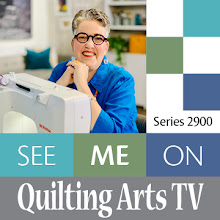 I’ve been really excited about this for a while, but didn't want to say anything until all the details were firmed up ... I'm going to be teaching online this fall through Joggles.com!
I’ve been really excited about this for a while, but didn't want to say anything until all the details were firmed up ... I'm going to be teaching online this fall through Joggles.com! Here are some photos of the projects I'll be teaching in "Tyvek: Explorations for the Creative Stitcher." First, a small quilted piece with Tyvek leaves:

A bracelet made from beaded Tyvek pieces (flat view):

The same bracelet (shown connected):

A practice sample showing the same technique used on the maple leaf quilt above:

And a few pins made with Tyvek embellished with thread, perle cotton embroidery and beads:

"Tyvek: Explorations for the Creative Stitcher" will start on Wednesday, November 5, 2008, and will include four lessons for $40. Here's the class description:
Curious about how to use Tyvek® in art quilts and crafts? In this class we will cover safety instructions for working with Tyvek; painting Tyvek; melting it with an iron and/or heat gun; ways to manipulate Tyvek before heating to change the effects; making beads, and embossing Tyvek with rubber stamps.
The focus is on exploring the many ways this versatile material can be manipulated to create beautiful textural embellishments. You will be encouraged to experiment and share your work with fellow students in the class.
You will need to be a confident free-motion quilter to complete the maple leaf quilt; the other projects involve only simple embroidery and beading.
After you learn the techniques in the first two lessons, Susan will provide detailed instructions for making a small art quilt with Tyvek maple leaves; a bracelet; pins; beads; and small Tyvek embellishments for art quilts, artists’ trading cards and postcards.
If you don't know about Joggles, and you are an art quilter, fiber artist, or do mixed media art, you need to know about it! Joggles carries an amazing number of fabrics, beads, charms, tools, books, magazines, clay, doll supplies, fibers, and other cool stuff than your credit line can handle.
Joggles also has some wonderful online classes, including one I took over the summer on working in a studio journal. Taking this class has really changed the way I work and the way I create. It was a great way to experience learning from an accomplished, internationally known instructor. I think online learning is going to transform our lives in coming years, and since I teach locally and love it, my first thought after taking an online course was "I want to teach this way, too!"
Of course, nothing can take the place of learning face-to-face from a good instructor. But for people who live in rurual areas, or for people who want to study a subject that is not available in their area, online learning is ideal.
If you've never taken an online class, here's how it works (on Joggles, at least): You pay for the class by purchasing it on the Joggles website. A week to 10 days before the class, Joggles sends you a supply list and more information to get prepared.
On the first day of class, you receive an e-mail with the class web page URL, your User ID, and a password. You also receive a link to a PDF you download and read and/or print out. These documents are like the instructor's lecture, only with photos and specific how-tos, including exercises and instructions. You can work on the lessons at your convenience. You don't have to do anything on any particular day.
If you have problems, questions, or want to talk with other students in your class, you can log on to the class forums, which are like chat rooms or online groups. You can do this as much or as little as you want. The Studio Journals class I took had a huge number of people commenting and posting photos, and it was so much fun to see everyone's work, hear their ideas, and share constructive criticism.
To take part in an online class, you do need to have basic computer and internet skills. You have to know how to download and save documents to your computer's hard drive. For more details on all this, make sure you read the "How Online Classes Work" on the Joggles website.
You can check out the fall classes, including mine, on Joggles' class schedule here. Come join my class in November!






























































